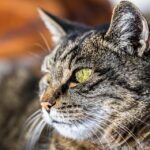Cats are known for their independent nature and quirky behaviors, but there is one time when even the most aloof kitty can exhibit unusual changes—during heat. Female cats, or queens, experience a reproductive cycle that can significantly affect their behavior. One of the most commonly observed changes is a loss of appetite. In this article, we will explore the reasons behind this phenomenon, the biological basis of a cat’s heat cycle, and tips for cat owners to navigate this challenging time.
Understanding the Feline Heat Cycle
The Basics of Feline Estrus
A female cat typically reaches sexual maturity between six months and one year of age. The heat cycle, or estrus, is a natural part of her reproductive process, which occurs primarily in the spring and summer. This cycle can last anywhere from a few days to several weeks, and it may repeat several times within a year if the cat is not bred.
The heat cycle consists of several stages:
Proestrus: This initial stage lasts one to two days and is characterized by subtle behavioral changes such as increased vocalization and affectionate behavior. However, the cat is not yet receptive to mating.
Estrus: This phase lasts about 3–14 days, during which the cat is receptive to male cats. Signs include increased vocalization, rolling on the floor, and strong affection. Importantly, during this time, the cat may start showing a significant decline in appetite.
Diestrus (or Metestrus): If the cat is not bred during estrus, she enters this phase, which can last about two weeks. Appetite may improve, but hormonal changes continue.
Anestrus: This is the resting phase, usually occurring in the fall and winter months when a cat is less likely to enter heat.
The Impact of Hormones on Appetite
During heat, a cat’s body undergoes substantial hormonal changes, particularly concerning estrogen. Estrogen levels rise significantly, affecting various physiological functions, including appetite. This hormonal surge can lead to a variety of behavioral changes, including a significant reduction in food intake.
Reasons for Loss of Appetite During Heat
Understanding the reasons behind a cat’s decreased appetite during heat can help owners manage their pets more effectively. Here are the primary factors:
1. Hormonal Changes
As discussed earlier, estrus triggers a surge in estrogen, impacting numerous bodily functions. This change can lead to a noticeable decrease in appetite. The hormonal fluctuation creates an intense focus on mating behaviors, which can make eating feel less essential.
2. Increased Activity and Stress
The heat cycle also stimulates increased activity. Queens may spend more time pacing and vocalizing, leading to a higher energy expenditure that does not correlate with food intake. Additionally, this heightened activity can cause stress and anxiety, contributing further to a loss of appetite.
3. Behavioral Changes
During heat, the behavioral changes in female cats can be quite pronounced. An increased desire to attract mates often overshadows basic needs such as eating. Cats may spend additional time grooming, venturing out, or marking territory, leading to distractions that reduce their focus on food.
4. Subtle Physical Discomfort
While many cats display enthusiasm and energy during heat, some may experience physical discomfort—such as mild cramping—associated with ovulation. This discomfort can deter them from feeling hungry or interested in food.
5. Environmental Factors
Anxiety and stress can be exacerbated by external factors, such as the presence of male cats nearby or being in a crowded or noisy environment. These stressors can further impact a queen’s appetite.
6. Underlying Health Issues
In some cases, a loss of appetite could indicate more serious health issues that coincidentally occur during the heat cycle. While most appetite loss during heat is normal, if the change persists or is accompanied by other concerning symptoms, it may necessitate a veterinary consultation to rule out conditions like dental disease, gastrointestinal issues, or infections.
Coping with a Cat’s Appetite Loss During Heat
As a cat owner, it is essential to recognize and address the appetite changes that occur during heat. Here are some tips for managing this period effectively:
1. Monitor Food Intake
It’s crucial to keep track of how much your cat is eating (or not eating) during her heat cycle. Note any changes in eating behavior and consult your veterinarian if the loss of appetite extends beyond the heat period or if there are other concerning symptoms.
2. Offer Palatable Food
Sometimes, a culinary adjustment can encourage a picky cat to eat. Offer her favorite wet food or try warming up the food slightly to enhance its aroma. Cats are often more attracted to strong smells and flavors during stressful periods.
3. Create a Comfortable Space
Providing a calm and quiet environment can help reduce stress and encourage eating. Designate a comfortable and safe space for your cat that is free from external stressors, such as other animals and loud noises.
4. Increase Playtime and Engagement
Engaging your cat in interactive play can help reduce anxiety and keep her focused. Provide toys and stimulation to keep her occupied, which may indirectly encourage her to eat.
5. Consider Feliway Products
Feliway is a synthetic pheromone that can help ease anxiety in cats. Using Feliway diffusers or sprays can create a calming atmosphere, potentially encouraging your cat to eat better.
6. Consult a Veterinarian
If your cat’s appetite loss persists after her heat cycle or if she exhibits other concerning symptoms, consult your veterinarian. They can help determine if there’s an underlying health issue that requires treatment.
Conclusion
The experience of heat can be a confusing time for both cats and their owners. Understanding the biological changes and behavioral patterns associated with this phase can help cat owners provide supportive care and alleviate concerns. While appetite loss during heat is relatively normal, it is essential to monitor your cat’s overall well-being. With proper care and attention, you can help your feline friend navigate this natural, albeit challenging, time in her life.
Featured Image Credit: Pixabay


